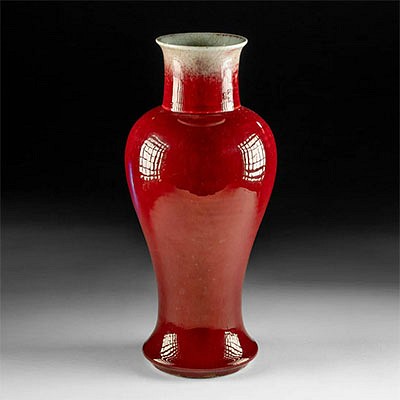Chinese Wei Alabaster Boddhisattva Guanyin
Lot 147
About Seller
Artemis Gallery
686 S Taylor Ave, Ste 106
Louisville, CO 80027
United States
Selling antiquities, ancient and ethnographic art online since 1993, Artemis Gallery specializes in Classical Antiquities (Egyptian, Greek, Roman, Near Eastern), Asian, Pre-Columbian, African / Tribal / Oceanographic art. Our extensive inventory includes pottery, stone, metal, wood, glass and textil...Read more
Categories
Estimate:
$2,000 - $3,000
Absentee vs Live bid
Two ways to bid:
- Leave a max absentee bid and the platform will bid on your behalf up to your maximum bid during the live auction.
- Bid live during the auction and your bids will be submitted real-time to the auctioneer.
Bid Increments
| Price | Bid Increment |
|---|---|
| $0 | $25 |
| $300 | $50 |
| $1,000 | $100 |
| $2,000 | $250 |
| $5,000 | $500 |
| $10,000 | $1,000 |
| $20,000 | $2,500 |
| $50,000 | $5,000 |
| $100,000 | $10,000 |
| $200,000 | $20,000 |
About Auction
By Artemis Gallery
May 11, 2023
Set Reminder
2023-05-11 10:00:00
2023-05-11 10:00:00
America/New_York
Bidsquare
Bidsquare : Fine Antiquities, Asian, Pre-Columbian, Ethnographic Art
https://www.bidsquare.com/auctions/artemis-gallery/fine-antiquities-asian-pre-columbian-ethnographic-art-12771
Classical antiquities, ancient and ethnographic art from cultures encompassing the globe. Artemis Gallery info@artemisgallery.com
Classical antiquities, ancient and ethnographic art from cultures encompassing the globe. Artemis Gallery info@artemisgallery.com
- Lot Description
**Originally Listed At $1200**
East Asia, China, Northern Wei or Northern Qi Dynasty, ca. 500 to 577 CE. A beautiful devotional example of the Boddhisattva Guanyin or Avalokiteshvara standing barefoot atop a lotus-shaped platform before a magnificent mandorla. Hand-carved from alabaster, Guanyin presents a dignified form while wearing flowing robes with lengthy sleeves and sashes and a diadem bearing ribbons that drape down over rounded shoulders. The protruding face exhibits a sensitive visage of almond-shaped eyes, a broad nose, and a petite smile. The boddhisattva holds a rounded flower bud in the right hand while the left hand is placed elegantly atop one hip. Bodhisattvas are among the most compassionate beings in the universe, devoting themselves to saving the suffering and helping others achieve enlightenment and Buddhahood. Guanyin, known outside China as Avalokitesvara, "The Lord Who Gazes Down At The World," is often portrayed as both male or female, and the soft but androgynous features of this example gives an impression of ethereal beauty. Size: 3.6" W x 9" H (9.1 cm x 22.9 cm)
The Wei Dynasty represents the beginning of Buddhist influence on Chinese art. It was made in a region of China that had a great deal of contact with the outside world and was ruled by foreign monarchs. After the Wei Dynasty ended, Buddhist art continued to flourish throughout the Sui Dynasty and into the Tang, when it achieved a golden age. This was also an economic golden age in China, when imperial control of oases along the Silk Road allowed both the export of Chinese goods and the import of people and ideas from places like India, Persia, and even further afield. The capital city, Changan (modern day Xian) had 2 million inhabitants, making it one of the largest cities in the world at the time, and there was a large class of literati and artisans supported by the government who lived there. This artisan class had the luxury to produce beautiful sculptures like this one.
PLEASE NOTE: Due to recent increases of shipments being seized by Australian & German customs (even for items with pre-UNESCO provenance), we will no longer ship most antiquities and ancient Chinese art to Australia & Germany. For categories of items that are acceptable to ship to Australia or Germany, please contact us directly or work with your local customs brokerage firm.
Provenance: private Hawaii collection, acquired 2000 to 2010
All items legal to buy/sell under U.S. Statute covering cultural patrimony Code 2600, CHAPTER 14, and are guaranteed to be as described or your money back.
A Certificate of Authenticity will accompany all winning bids.
We ship worldwide and handle all shipping in-house for your convenience.
#177430Professionally repaired with restoration and repainting over break lines. Small areas of loss to back left corner of base and proper right hand, as well as chipping to top of mandorla and peripheries. Expected nicks and abrasions commensurate with age, but otherwise in nice overall condition with good remaining detail and earthen encrustations. Root marks to base.Condition
- Shipping Info
-
All shipping is handled in-house for your convenience. Your invoice from Artemis Gallery will include shipping calculation instructions. If in doubt, please inquire BEFORE bidding for estimated shipping costs for individual items. In most cases Artemis Gallery cannot ship to Australia and Germany, please inquire before bidding.
-
- Buyer's Premium



 EUR
EUR CAD
CAD AUD
AUD GBP
GBP MXN
MXN HKD
HKD CNY
CNY MYR
MYR SEK
SEK SGD
SGD CHF
CHF THB
THB















